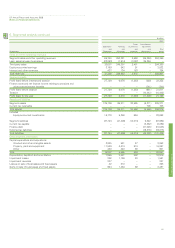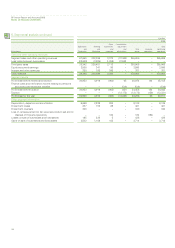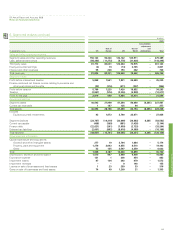BP 2008 Annual Report Download - page 114
Download and view the complete annual report
Please find page 114 of the 2008 BP annual report below. You can navigate through the pages in the report by either clicking on the pages listed below, or by using the keyword search tool below to find specific information within the annual report.
BP Annual Report and Accounts 2008
Notes on financial statements
1. Significant accounting policies continued
Hedges of a net investment in a foreign operation
For hedges of a net investment in a foreign operation, the effective
portion of the gain or loss on the hedging instrument is recognized
directly in equity, while the ineffective portion is recognized in profit or
loss. Amounts taken to equity are transferred to the income statement
when the foreign operation is sold or partially disposed.
Embedded derivatives
Derivatives embedded in other financial instruments or other host
contracts are treated as separate derivatives when their risks and
characteristics are not closely related to those of the host contract.
Contracts are assessed for embedded derivatives when the group
becomes a party to them, including at the date of a business
combination. Embedded derivatives are measured at fair value at
each balance sheet date. Any gains or losses arising from changes in
fair value are taken directly to profit or loss.
Provisions and contingencies
Provisions are recognized when the group has a present obligation (legal
or constructive) as a result of a past event, it is probable that an outflow of
resources embodying economic benefits will be required to settle the
obligation and a reliable estimate can be made of the amount of the
obligation. Where appropriate, the future cash flow estimates are adjusted
to reflect risks specific to the liability.
If the effect of the time value of money is material, provisions are
determined by discounting the expected future cash flows at a pre-tax
rate that reflects current market assessments of the time value of
money. Where discounting is used, the increase in the provision due to
the passage of time is recognized within finance costs.
A contingent liability is disclosed where the existence of an
obligation will only be confirmed by future events or where the amount
of the obligation cannot be measured reliably. Contingent assets are
not recognized, but are disclosed where an inflow of economic
benefits is probable.
Decommissioning
Liabilities for decommissioning costs are recognized when the group has
an obligation to dismantle and remove a facility or an item of plant and to
restore the site on which it is located, and when a reliable estimate of that
liability can be made. Where an obligation exists for a new facility, such as
oil and natural gas production or transportation facilities, this will be on
construction or installation. An obligation for decommissioning may also
crystallize during the period of operation of a facility through a change in
legislation or through a decision to terminate operations. The amount
recognized is the present value of the estimated future expenditure
determined in accordance with local conditions and requirements.
A corresponding item of property, plant and equipment of an
amount equivalent to the provision is also created. This is subsequently
depreciated as part of the asset.
Other than the unwinding discount on the provision, any change
in the present value of the estimated expenditure is reflected as an
adjustment to the provision and the corresponding item of property,
plant and equipment.
Environmental expenditures and liabilities
Environmental expenditures that relate to current or future revenues are
expensed or capitalized as appropriate. Expenditures that relate to an
existing condition caused by past operations and do not contribute to
current or future earnings are expensed.
Liabilities for environmental costs are recognized when a clean-up
is probable and the associated costs can be reliably estimated. Generally,
the timing of recognition of these provisions coincides with the
commitment to a formal plan of action or, if earlier, on divestment or on
closure of inactive sites.
The amount recognized is the best estimate of the expenditure
required. Where the liability will not be settled for a number of years,
the amount recognized is the present value of the estimated
future expenditure.
Employee benefits
Wages, salaries, bonuses, social security contributions, paid annual leave
and sick leave are accrued in the period in which the associated services
are rendered by employees of the group. Deferred bonus arrangements
that have a vesting date more than 12 months after the period end are
valued on an actuarial basis using the projected unit credit method and
amortized on a straight-line basis over the service period until the award
vests. The accounting policy for pensions and other post-retirement
benefits is described below.
Share-based payments
Equity-settled transactions
The cost of equity-settled transactions with employees is measured by
reference to the fair value at the date at which equity instruments are
granted and is recognized as an expense over the vesting period, which
ends on the date on which the relevant employees become fully entitled
to the award. Fair value is determined by using an appropriate valuation
model. In valuing equity-settled transactions, no account is taken of any
vesting conditions, other than conditions linked to the price of the shares
of the company (market conditions).
No expense is recognized for awards that do not ultimately vest,
except for awards where vesting is conditional upon a market condition,
which are treated as vesting irrespective of whether or not the market
condition is satisfied, provided that all other performance conditions
are satisfied.
At each balance sheet date before vesting, the cumulative
expense is calculated, representing the extent to which the vesting
period has expired and management’s best estimate of the achievement
or otherwise of non-market conditions and the number of equity
instruments that will ultimately vest or, in the case of an instrument
subject to a market condition, be treated as vesting as described above.
The movement in cumulative expense since the previous balance sheet
date is recognized in the income statement, with a corresponding entry
in equity.
Where the terms of an equity-settled award are modified or a
new award is designated as replacing a cancelled or settled award, the
cost based on the original award terms continues to be recognized over
the original vesting period. In addition, an expense is recognized over
the remainder of the new vesting period for the incremental fair value of
any modification, based on the difference between the fair value of the
original award and the fair value of the modified award, both as measured
on the date of the modification. No reduction is recognized if this
difference is negative.
Where an equity-settled award is cancelled, it is treated as if it
had vested on the date of cancellation and any cost not yet recognized
in the income statement for the award is expensed immediately. Any
compensation paid up to the fair value of the award at the cancellation
or settlement date is deducted from equity, with any excess over fair
value being treated as an expense in the income statement.
Financial statements
113
























